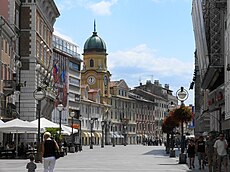Rijeka
| Rijeka | ||||||||
|---|---|---|---|---|---|---|---|---|
| City | ||||||||
|
Grad Rijeka City of Rijeka |
||||||||
Rijeka
|
||||||||
|
||||||||
| Nickname(s): Mayor of the Adriatic | ||||||||
| Location of Rijeka within Croatia | ||||||||
| Coordinates: 45°19′N 14°25′E / 45.317°N 14.417°ECoordinates: 45°19′N 14°25′E / 45.317°N 14.417°E | ||||||||
| Country |
|
|||||||
| County | Primorje-Gorski Kotar | |||||||
| Government | ||||||||
| • Mayor | Vojko Obersnel (SDP) | |||||||
| • City Council |
Six parties/lists
|
|||||||
| Area | ||||||||
| • City | 44 km2 (17 sq mi) | |||||||
| • Urban | 825 km2 (319 sq mi) | |||||||
| • Metro | 1,665 km2 (643 sq mi) | |||||||
| Elevation | 0–499 m (0 – 1,561 ft) | |||||||
| Population (2017.) | ||||||||
| • City | 128,624 | |||||||
| • Density | 2,923/km2 (7,570/sq mi) | |||||||
| • Urban | 213,666 | |||||||
| • Urban density | 259/km2 (670/sq mi) | |||||||
| • Metro | 245,054 | |||||||
| • Metro density | 147/km2 (380/sq mi) | |||||||
| Time zone | CET (UTC+1) | |||||||
| • Summer (DST) | CEST (UTC+2) | |||||||
| Postal code | 51000 | |||||||
| Area code(s) | 051 | |||||||
| Vehicle registration | RI | |||||||
| Patron saints | St. Vitus | |||||||
| Website | http://www.rijeka.hr | |||||||
Rijeka (Croatian pronunciation: [rijěːka]; Italian: Fiume [ˈfjuːme]; Hungarian: Fiume; Slovene: Reka; German: Sankt Veit am Flaum; see other names) is the principal seaport and the third-largest city in Croatia (after Zagreb and Split). It is located on Kvarner Bay, an inlet of the Adriatic Sea and has a population of 128,624 inhabitants (2011). The metropolitan area, which includes adjacent towns and municipalities, has a population of more than 240,000.
In 2016, Rijeka was selected as the European Capital of Culture for 2020, alongside Galway, Ireland.
Historically, because of its strategic position and its excellent deep-water port, the city was fiercely contested, especially among Italy, Hungary (serving as the Kingdom of Hungary's largest and most important port), and Croatia, changing hands and demographics many times over centuries. According to the 2011 census data, the overwhelming majority of its citizens (82.52%) are presently Croats, along with small numbers of Bosniaks, Italians and Serbs.
...
Wikipedia








